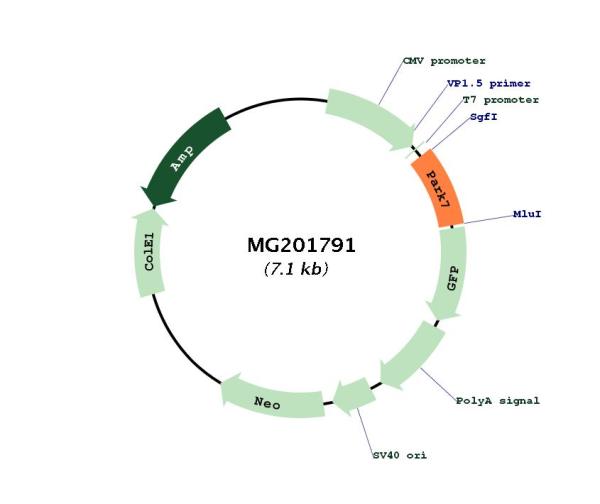Park7 (NM_020569) Mouse Tagged ORF Clone
CAT#: MG201791
- TrueORF®
Park7 (tGFP-tagged) - Mouse Parkinson disease (autosomal recessive, early onset) 7 (Park7)
ORF Plasmid: DDK
"NM_020569" in other vectors (4)
Need custom modification / cloning service?
Get a free quote
CNY 2,850.00
CNY 1,000.00
Specifications
| Product Data | |
| Type | Mouse Tagged ORF Clone |
| Tag | TurboGFP |
| Synonyms | DJ-1; Dj1 |
| Vector | pCMV6-AC-GFP |
| E. coli Selection | Ampicillin (100 ug/mL) |
| Mammalian Cell Selection | Neomycin |
| Sequence Data |
>MG201791 representing NM_020569
Red=Cloning site Blue=ORF Green=Tags(s) TTTTGTAATACGACTCACTATAGGGCGGCCGGGAATTCGTCGACTGGATCCGGTACCGAGGAGATCTGCC GCCGCGATCGCC ATGGCTTCCAAAAGAGCTCTGGTCATCCTGGCCAAAGGAGCAGAGGAGATGGAGACAGTGATTCCTGTGG ATGTCATGCGGCGAGCCGGGATCAAAGTCACTGTTGCAGGCTTGGCTGGGAAGGACCCCGTGCAGTGTAG CCGTGATGTAATGATTTGTCCAGATACCAGTCTGGAAGATGCAAAAACGCAGGGACCATACGATGTGGTG GTTCTTCCAGGAGGAAATCTGGGTGCACAGAATTTATCTGAGTCGCCTATGGTGAAGGAGATCCTCAAGG AGCAGGAGAGCAGGAAGGGCCTCATAGCTGCCATCTGTGCAGGTCCTACGGCTCTGTTGGCTCACGAAGT AGGTTTTGGATGCAAGGTCACAACACACCCACTGGCTAAGGACAAAATGATGAATGGCAGTCACTACAGC TACTCAGAGAGCCGCGTGGAGAAGGACGGCCTGATCCTCACCAGCCGCGGGCCGGGGACCAGCTTTGAGT TTGCACTAGCCATTGTGGAGGCACTCGTGGGGAAAGACATGGCCAACCAAGTGAAGGCACCGCTTGTTCT CAAAGAC ACGCGTACGCGGCCGCTCGAG - GFP Tag - GTTTAA >MG201791 representing NM_020569
Red=Cloning site Green=Tags(s) MASKRALVILAKGAEEMETVIPVDVMRRAGIKVTVAGLAGKDPVQCSRDVMICPDTSLEDAKTQGPYDVV VLPGGNLGAQNLSESPMVKEILKEQESRKGLIAAICAGPTALLAHEVGFGCKVTTHPLAKDKMMNGSHYS YSESRVEKDGLILTSRGPGTSFEFALAIVEALVGKDMANQVKAPLVLKD TRTRPLE - GFP Tag - V |
| Restriction Sites |
SgfI-MluI
Cloning Scheme for this gene
Plasmid Map

|
| ACCN | NM_020569 |
| ORF Size | 567 bp |
| OTI Disclaimer | The molecular sequence of this clone aligns with the gene accession number as a point of reference only. However, individual transcript sequences of the same gene can differ through naturally occurring variations (e.g. polymorphisms), each with its own valid existence. This clone is substantially in agreement with the reference, but a complete review of all prevailing variants is recommended prior to use. More info |
| OTI Annotation | This clone was engineered to express the complete ORF with an expression tag. Expression varies depending on the nature of the gene. |
| Product Components | The ORF clone is ion-exchange column purified and shipped in a 2D barcoded Matrix tube containing 10ug of transfection-ready, dried plasmid DNA (reconstitute with 100 ul of water). |
| Reconstitution | 1. Centrifuge at 5,000xg for 5min. 2. Carefully open the tube and add 100ul of sterile water to dissolve the DNA. 3. Close the tube and incubate for 10 minutes at room temperature. 4. Briefly vortex the tube and then do a quick spin (less than 5000xg) to concentrate the liquid at the bottom. 5. Store the suspended plasmid at -20°C. The DNA is stable for at least one year from date of shipping when stored at -20°C. |
| Reference Data | |
| RefSeq | NM_020569.3, NP_065594.2 |
| RefSeq Size | 920 bp |
| RefSeq ORF | 570 bp |
| Locus ID | 57320 |
| UniProt ID | Q99LX0 |
| Gene Summary | Protein and nucleotide deglycase that catalyzes the deglycation of the Maillard adducts formed between amino groups of proteins or nucleotides and reactive carbonyl groups of glyoxals. Thus, functions as a protein deglycase that repairs methylglyoxal- and glyoxal-glycated proteins, and releases repaired proteins and lactate or glycolate, respectively. Deglycates cysteine, arginine and lysine residues in proteins, and thus reactivates these proteins by reversing glycation by glyoxals. Acts on early glycation intermediates (hemithioacetals and aminocarbinols), preventing the formation of advanced glycation endproducts (AGE) that cause irreversible damage. Also functions as a nucleotide deglycase able to repair glycated guanine in the free nucleotide pool (GTP, GDP, GMP, dGTP) and in DNA and RNA. Is thus involved in a major nucleotide repair system named guanine glycation repair (GG repair), dedicated to reversing methylglyoxal and glyoxal damage via nucleotide sanitization and direct nucleic acid repair (By similarity). Also displays an apparent glyoxalase activity that in fact reflects its deglycase activity (PubMed:22523093). Plays an important role in cell protection against oxidative stress and cell death acting as oxidative stress sensor and redox-sensitive chaperone and protease; functions probably related to its primary function (PubMed:15784737, PubMed:17015834, PubMed:20800516, PubMed:21068725). It is involved in neuroprotective mechanisms like the stabilization of NFE2L2 and PINK1 proteins, male fertility as a positive regulator of androgen signaling pathway as well as cell growth and transformation through, for instance, the modulation of NF-kappa-B signaling pathway (PubMed:17015834, PubMed:21097510). Eliminates hydrogen peroxide and protects cells against hydrogen peroxide-induced cell death (PubMed:17766438). Required for correct mitochondrial morphology and function as well as for autophagy of dysfunctional mitochondria (PubMed:20186336). Plays a role in regulating expression or stability of the mitochondrial uncoupling proteins SLC25A14 and SLC25A27 in dopaminergic neurons of the substantia nigra pars compacta and attenuates the oxidative stress induced by calcium entry into the neurons via L-type channels during pacemaking (PubMed:21068725). Regulates astrocyte inflammatory responses, may modulate lipid rafts-dependent endocytosis in astrocytes and neuronal cells (PubMed:23847046, PubMed:19276172). In pancreatic islets, involved in the maintenance of mitochondrial reactive oxygen species (ROS) levels and glucose homeostasis in an age- and diet dependent manner (PubMed:22611253). Protects pancreatic beta cells from cell death induced by inflammatory and cytotoxic setting (PubMed:26422139). Binds to a number of mRNAs containing multiple copies of GG or CC motifs and partially inhibits their translation but dissociates following oxidative stress (By similarity). Metal-binding protein able to bind copper as well as toxic mercury ions, enhances the cell protection mechanism against induced metal toxicity (PubMed:23792957). In macrophages, interacts with the NADPH oxidase subunit NCF1 to direct NADPH oxidase-dependent ROS production, and protects against sepsis (PubMed:26021615).[UniProtKB/Swiss-Prot Function] |
Documents
| Product Manuals |
| FAQs |
| SDS |
Resources
Other Versions
| SKU | Description | Size | Price |
|---|---|---|---|
| MC205599 | Park7 (untagged) - Mouse Parkinson disease (autosomal recessive, early onset) 7 (Park7), (10ug) |
CNY 2,000.00 |
|
| MR201791 | Park7 (Myc-DDK-tagged) - Mouse Parkinson disease (autosomal recessive, early onset) 7 (Park7) |
CNY 2,400.00 |
|
| MR201791L3 | Lenti ORF clone of Park7 (Myc-DDK-tagged) - Mouse Parkinson disease (autosomal recessive, early onset) 7 (Park7) |
CNY 4,750.00 |
|
| MR201791L4 | Lenti ORF clone of Park7 (mGFP-tagged) - Mouse Parkinson disease (autosomal recessive, early onset) 7 (Park7) |
CNY 4,750.00 |


 United States
United States
 Germany
Germany
 Japan
Japan
 United Kingdom
United Kingdom
 China
China

